The full article about the First Watt F8 is now available at Positive Feedback to read HERE. Enjoy!
As is my custom, I like to show you a "sneak peek" of upcoming articles for Positive Feedback.
In this sneak peek you'll see a preview of my upcoming The New First Watt F8 Stereo Amplifier from Nelson Pass: Time Travel In a Black Box! article for Positive Feedback.
Incidentally, the reference to a 'black box' in the title isn't a comment about the black chassis of the F8 I'm writing about, although it could be, but rather "In science, computing, and engineering, a black box is a system which can be viewed in terms of its inputs and outputs (or transfer characteristics), without any knowledge of its internal workings."
In other words, "Time Travel In a Black Box!" is a play on words that follows along with the themes of physics and time travel in this article, which will become more apparent as you read through it.
I hope you enjoy reading this sneak peek about the First Watt F8 stereo amplifier!
Whether musing about the greater understanding the Belle II particle physics experiment at KEK may bring to questions around Standard Model predictions, dark matter, and the asymmetry of matter and antimatter in the universe, or the exciting themes of parallel universes, the multiverse, and time travel that we see imaginatively explored in science fiction, physics remains an enduringly illuminating field of study for opening up one's mind to the unseen possibilities of our phenomenal world.
That also aligns well with my own experience with the physicists I have known or worked with over the years, as they have proved to be a highly intelligent, imaginative, and creative group on many levels.
Take Nelson Pass as an example. Nelson studied physics at UC Davis, earning a Bachelor of Science in physics in 1974.
I asked Nelson if he would tell us a little about how that intersection of physics and his creative interests in audio influenced the direction of his life.

"USSR stamp depicting Sputnik 1 orbiting the Earth, the Earth orbiting the Sun and the Sun orbiting the centre of the Milky Way galaxy." Public domain image courtesy of Wikipedia.
“When I was very young the Soviets had launched Sputnik and the government became interested in finding and developing “young scientific talent”, and as I had scored highly on IQ tests I was the focus of some attention. Throughout my education it was assumed that I would be a mathematician or physicist.”
“But halfway through my time at Davis I decided I liked playing with audio equipment more and I began building speakers and amplifiers. I ended up at ESS just before the “Heil years”, learning physics and math by day and doing speaker development by night (I met my wife Jill there – she was assembling Heil diaphragms). Amplifier design beckoned, and I left ESS to form Threshold, and later Pass Labs and First Watt.”

Photograph by David W. Robinson, copyright (c) 2018, all rights reserved.
“So here I am 50 years later, happily building amplifiers and the occasional loudspeaker, devoted to electronic design as art. I look for performance in simplicity and elegance, making subtle choices of topologies and components. I think it’s worked out quite well.”
I think Nelson’s ‘physics by day, audio research by night’ lifestyle during his formative years as an audio designer is a fascinating story.
That same sort of intelligence and imaginative creativity that has brought us KEK and CERN from physicists, brought us Threshold, Pass Labs, and First Watt, courtesy of Nelson Pass’ devotion “to electronic design as art”.
While the physicists at KEK and CERN continue to probe the boundaries of what is known and possible about the phenomenal world as it relates to particle physics, it is Nelson’s enduring physics-enabled creative research into the audio arts that has brought us music and audio enthusiasts a form of transcendental illumination that helps bridge the gap between phenomenon and noumenon in the world of music and the recording arts that document it.
The intelligence and creativity that Nelson has applied to the audio arts over the years means that each new design from Nelson is greeted with a level of enthusiasm only rarely seen for other audio products, as enthusiasts know each new First Watt amplifier will be at the cutting-edge of solid-state design creativity, will sound fantastic, will be ultra-reliable, and will be affordable.
Certainly, I was very enthusiastic for all those same reasons when I heard that I was going to be able to write about the new First Watt F8 amplifier for you here at Positive Feedback.
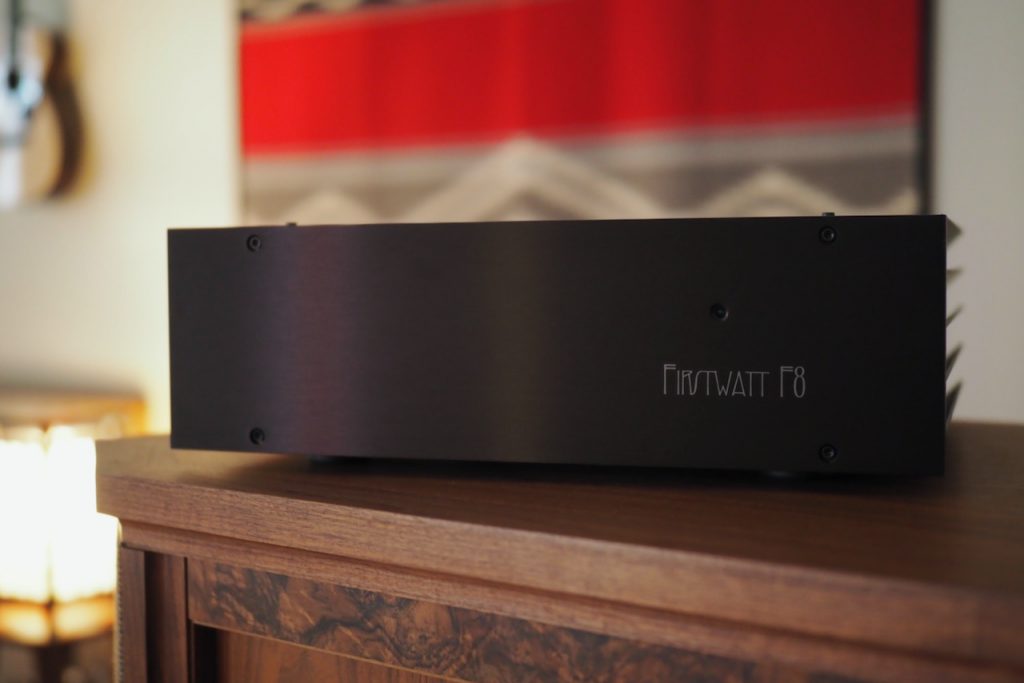
The new First Watt F8 stereo amplifier from Nelson Pass. $4000 USD.
I’ve been a fan of Nelson’s design prowess ever since I bought a Pass Labs Aleph 3 back in 1997 (photo below).

Aleph 3 photograph courtesy of Nelson Pass.
I thought the Aleph 3 was an awesome looking amplifier. Bristling with cooling fins on all four sides, the Aleph 3 looked like it meant business.
Nelson was inspired by the sound quality and musicality of single-ended-triode vacuum tube amplifiers, and creatively incorporated analogs of those design principles into the Aleph 3, which represented a revolutionary step forward in solid-state amplifier design with its single-ended topology with only two gain stages.
Not only did the Aleph 3 have winning good looks and a ground-breaking new singled-ended solid-state amplifier design, it also sounded great and possessed superb musicality, while being affordable enough to be accessible to us working class blokes at $2300 USD (about $3,983 USD in today’s inflation corrected dollars).
One thing you can count on from Nelson Pass is the ingenuity and creativity of his designs, which always have a canny balance of high-fidelity sound quality and musicality that brings recorded musical performances forth with a compelling vision of live-likeness, so whenever Nelson releases a new amplifier its a big deal for yours truly.
With that, I enter into the world of the First Watt F8 stereo amplifier.
The First Watt F8 Stereo Amplifier ($4000 USD)
Like my Aleph 3 of yesteryear, Nelson’s First Watt F8 is a low-powered two-stage single-ended Class A stereo amplifier, and is offered in that same spirit of affordable excellence at $4000 USD, which is within a few dollars of being the same price in inflation corrected dollars that I paid for my Aleph 3 back in 1997.

The new First Watt F8 stereo amplifier from Nelson Pass.
The 25 watt per channel First Watt F8 isn’t related design-wise to the Aleph 3, however, but rather the F8 is an evolutionary descendant of the 25 watt per channel First Watt J2 amplifier, which has been the most enduringly popular First Watt amplifier ever offered by Nelson.
The First Watt J2 amplifier utilizes signal JFETs for the input stage, and power JFETs for the output stage, about which Nelson says:
“JFET transistors have long been recognized as having the highest audio quality of any transistor; the input devices of the J2 are known through the industry as the standard for low noise and linearity, and are found on the inputs of the finest phono stages, line level preamplifiers, and power amplifiers.”
The power JFETs in the First Watt J2’s single-ended Class A output stage use “about half the feedback of a comparable MOSFET circuit but with half the distortion and twice the bandwidth,” so that’s quite an advancement over a MOSFET circuit like that of my old Aleph 3.
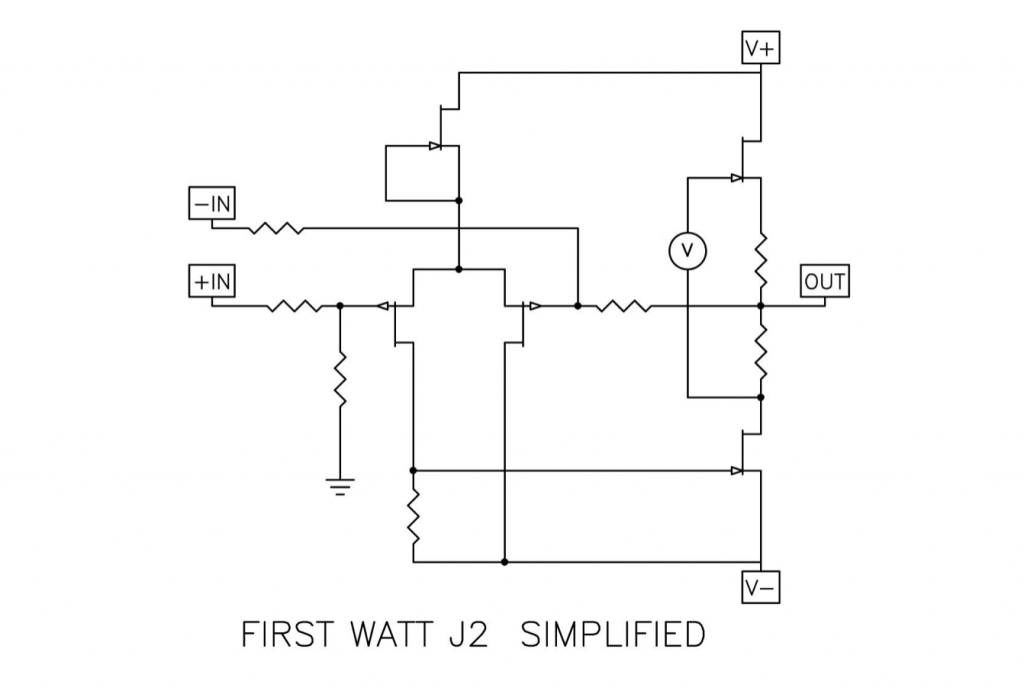
J2 circuit image courtesy of Nelson Pass.
About the J2, Nelson said, “The J2 power amplifier is simple, clean, and measures astonishingly well. It achieves a sound which is warm and relaxed, combining precision and detail without sterility. With a pair of sensibly efficient loudspeakers, it will give you a toe-tapping experience that other solid state amplifiers do not. The design is extremely reliable and will never need adjustment.”
Nelson’s inspiration for the F8 was that he wanted to design an amplifier with the same SemiSouth SiC R100 power JFETs used in the output stage of the J2, but with an improved input circuit.
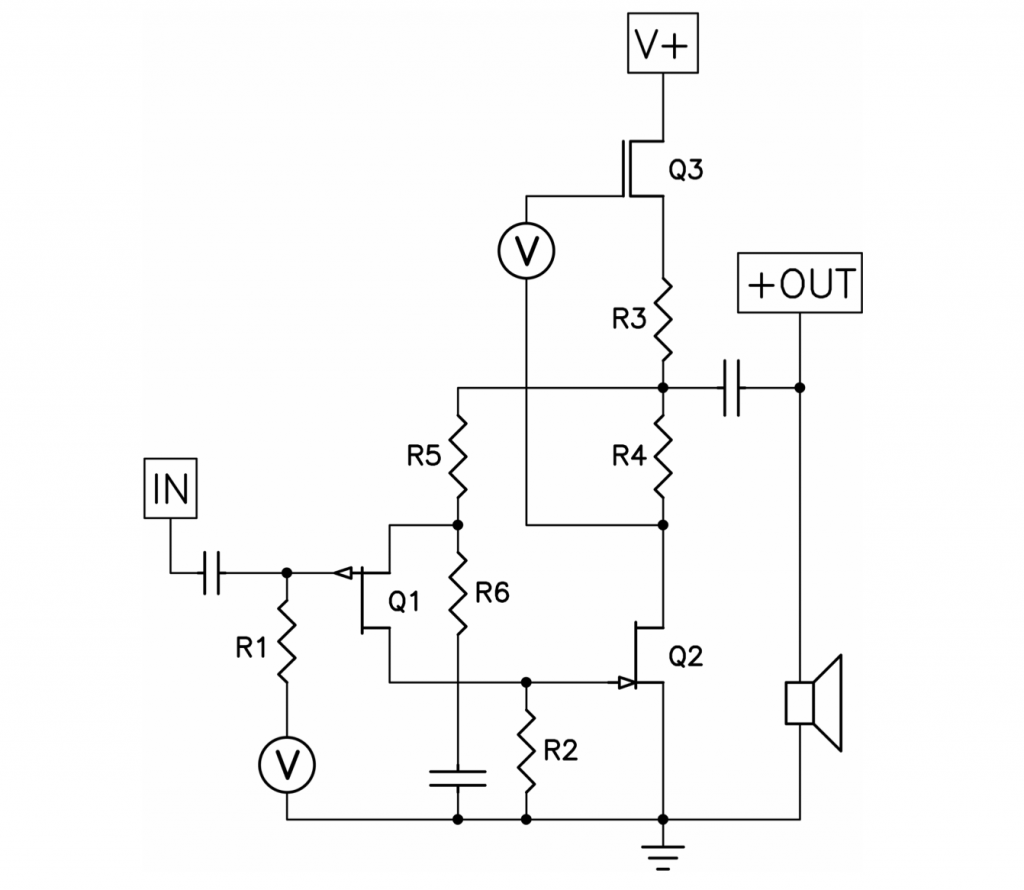
F8 circuit image courtesy of Nelson Pass.
The output stage of the F8 is the same as that of the J2, but where the J2 uses 6 JFETs in the input circuit, the F8 uses a single Toshiba 2SJ74 P channel JFET.
Nelson on the new input circuit:
“Five fewer transistors is part of the difference - the J2 input topology is what we refer to as a VFA, or ‘voltage feedback amplifier’. The F8 would be referred to as a CFA, or ‘current feedback amplifier’.”
“Both approaches to feedback have their advantages, and there are adherents for both. In this case, the CFA topology gives several advantages - simpler circuit, simpler/smoother transfer characteristic and a little better performance by measurement.”
“As you compare the J2 and the F8, you will find quite a bit of similarity, but the F8 is a modest improvement in several areas. In particular, the damping factor and high frequency response are twice as good, and distortion numbers are lower. I am pleased to note that this is achieved with 10 dB less open loop gain on the circuit and 5 dB less feedback.”
“Still, this is not the primary thing - it's just what I can show you in print. The real merit to the amplifier is in the experience of listening. This is a matter of how compatible it is with the rest of the audio system and the taste of the listener.”
“You will have noticed, I enjoy amplifiers with a little personality. They don't have to measure perfectly, they just have to sound good. This is a simple little Class A amplifier with a very nice personality, and I hope you like it.”

A quick perusal of the First Watt F8 stereo amplifier reveals a rather demure appearance that largely disappears into a late-night listening room. It’s as if the F8 is saying, “It is not my looks, but the music I make, that will inspire you.”
From the front, you’ll see a softly illuminated blue indicator light when the amplifier is powered up. On each side are finned heatsinks that dissipate the circuits’ heat.

Around back you see two pairs of binding posts, a pair of RCA inputs, a fuse holder, an IEC connector to plug a power cord into, and a power switch.
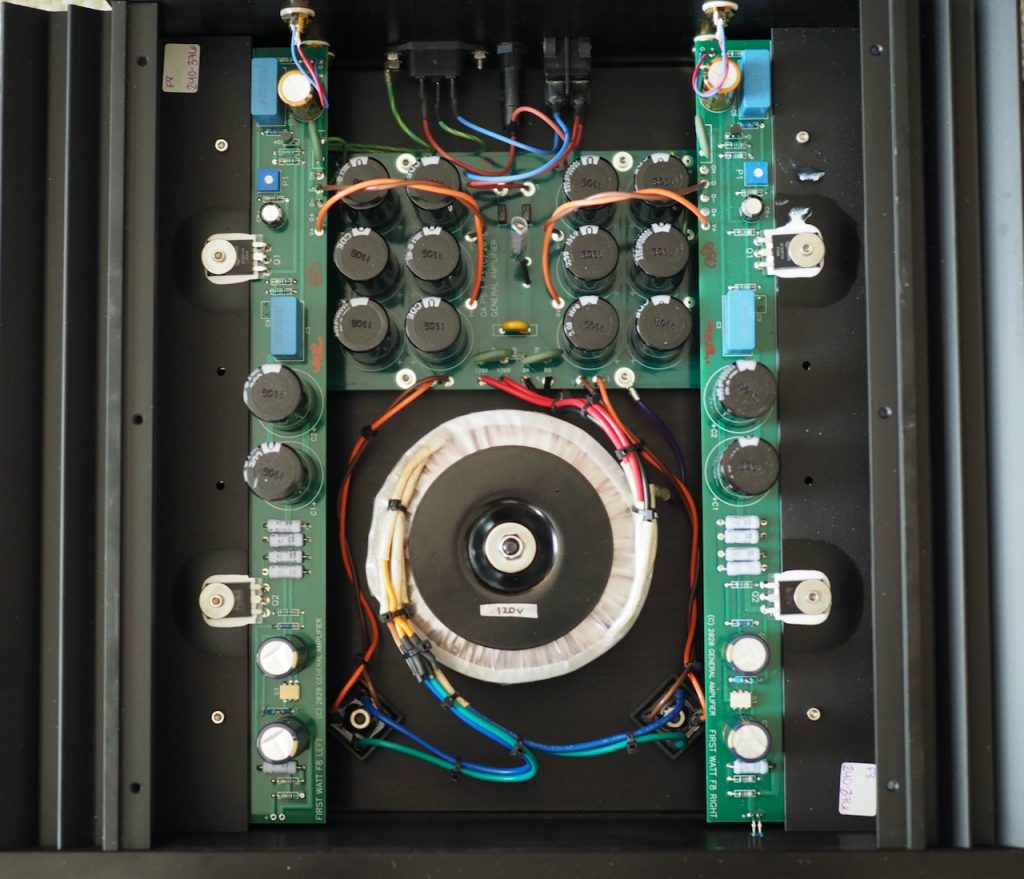
On the bottom are elastomer footers, but its when you remove the top-plate that you see where the electronic wizardry takes place.
Associated Equipment
Nelson's description of First Watt's target listeners is, "If you have efficient loudspeakers, listen at reasonable levels and are obsessed about subjective performance, then you probably have come to the right place. If you want reliable audio product, then you really have come to the right place."
Nelson’s First Watt target listeners sound a lot like a description of me. My Tannoy Westminster Royal Special Edition loudspeakers are rated by Tannoy at a highish 99dB sensitivity. I confess that I am rather obsessed with subjective performance, as I want my amplifiers to have the ‘sound of music’ in their circuitry that makes listening to recorded performances of music fun and illuminating. I also appreciate the fact that Nelson offers amplifiers with bleeding-edge performance, that are also affordable, and completely reliable.
Probably the only area I diverge from Nelson’s target listeners is that I sometimes like to listen at ‘unreasonable’ levels. Can the 25 watt First Watt F8 deliver live-like levels from my loudspeakers? Yes it can.
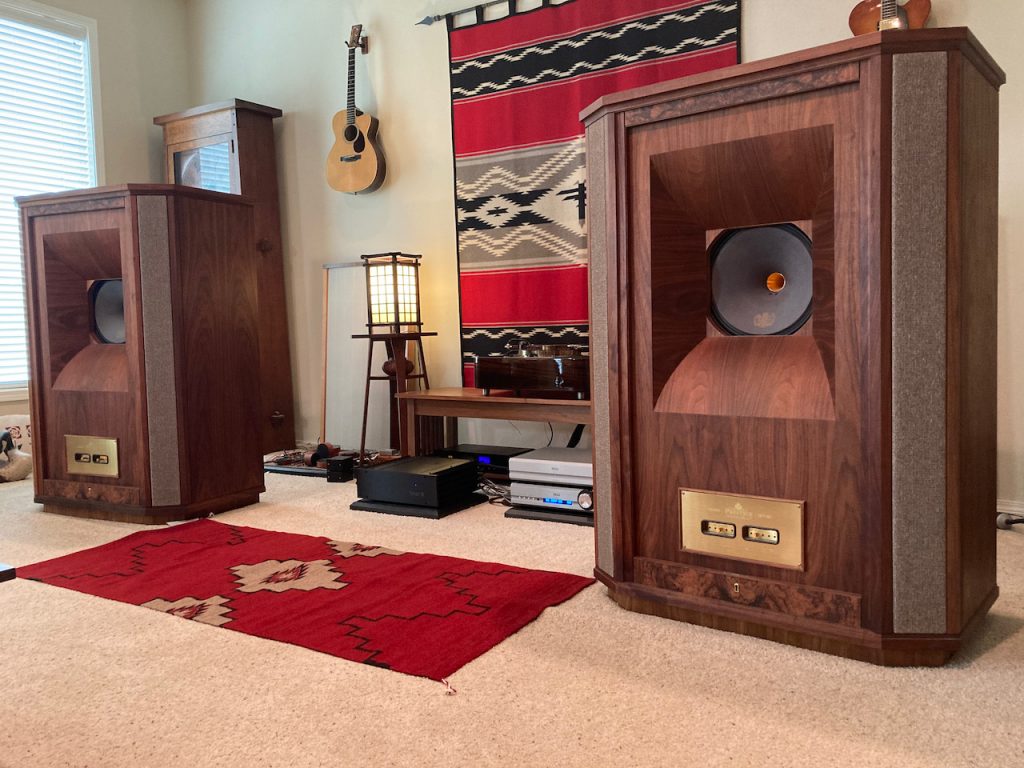
Nelson employs 15-inch Tannoy Dual Concentric drivers in custom cabinets as part of his design process for amplifiers, which you can see in the photo below.
I can tell you from first-hand experience with prior First Watt and Pass Labs components, that they are an extremely good match to my Tannoy loudspeakers. Fellow Tannoy owners should take note.
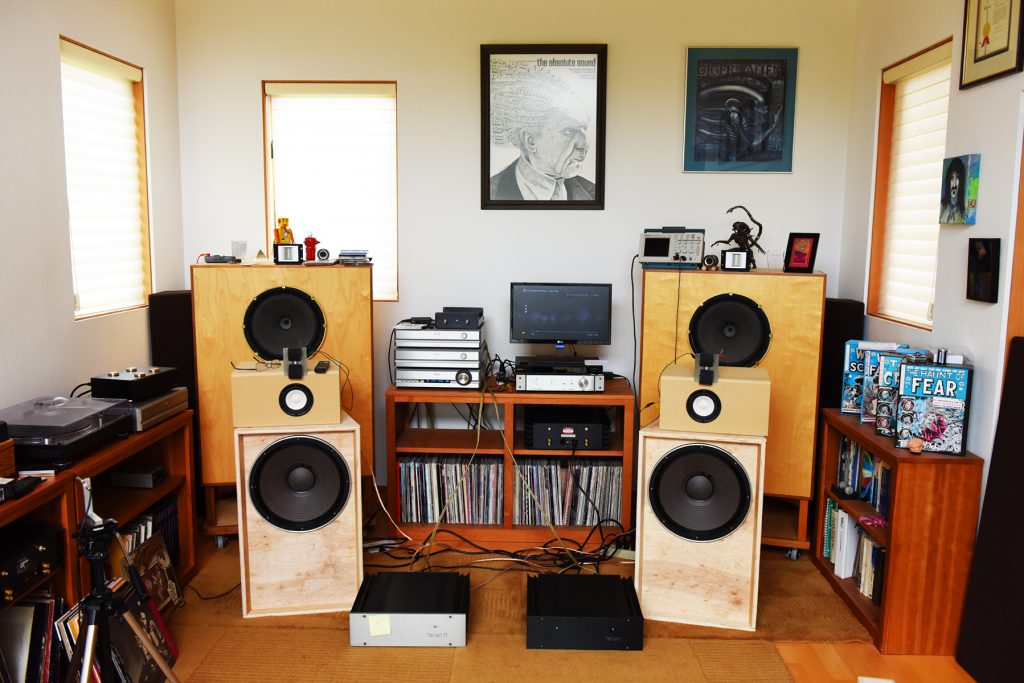
Nelson's home listening room. Photograph by David W. Robinson, copyright (c) 2018, all rights reserved.
My Westminster Royal SE loudspeakers stock crossovers have been replaced with custom crossovers consisting of Duelund CAST components, with pure silver Duelund CAST components in the high-frequency circuit, which provide a remarkably deep glimpse into the performance of upstream components (more HERE).
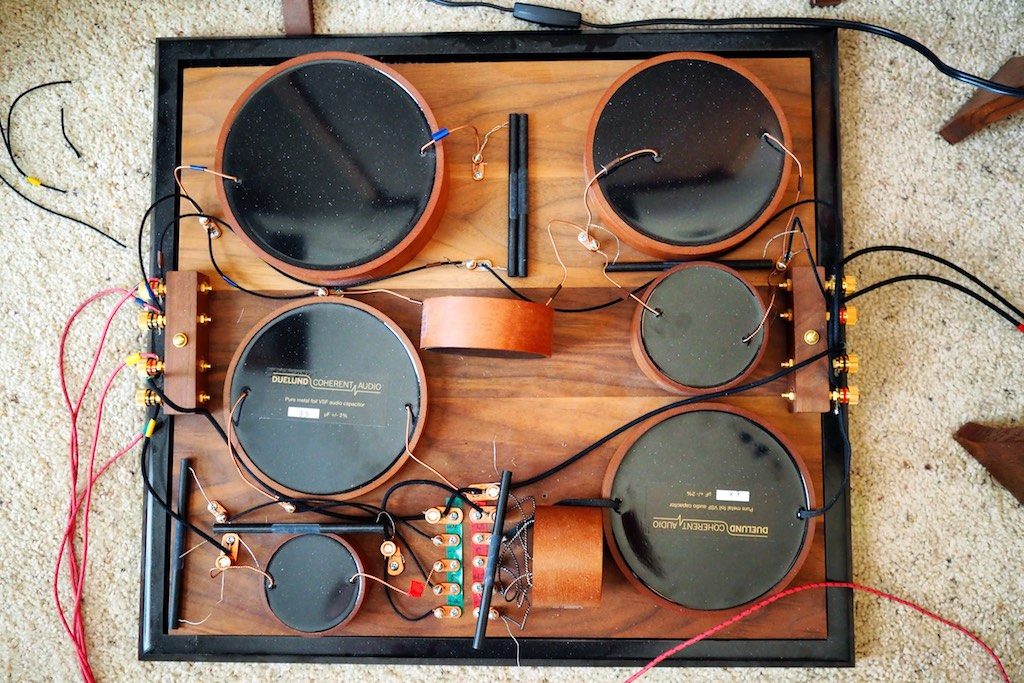
Duelund CAST crossover for a Tannoy Westminster loudspeaker.
I used Duelund DCA16GA tinned-copper speaker cables to connect the First Watt F8 stereo amplifier to my Westminsters.
The Pass Labs XP-12 line-level preamplifier (more HERE) and XP-17 phono preamplifier (more HERE) performed the preampfification duties.
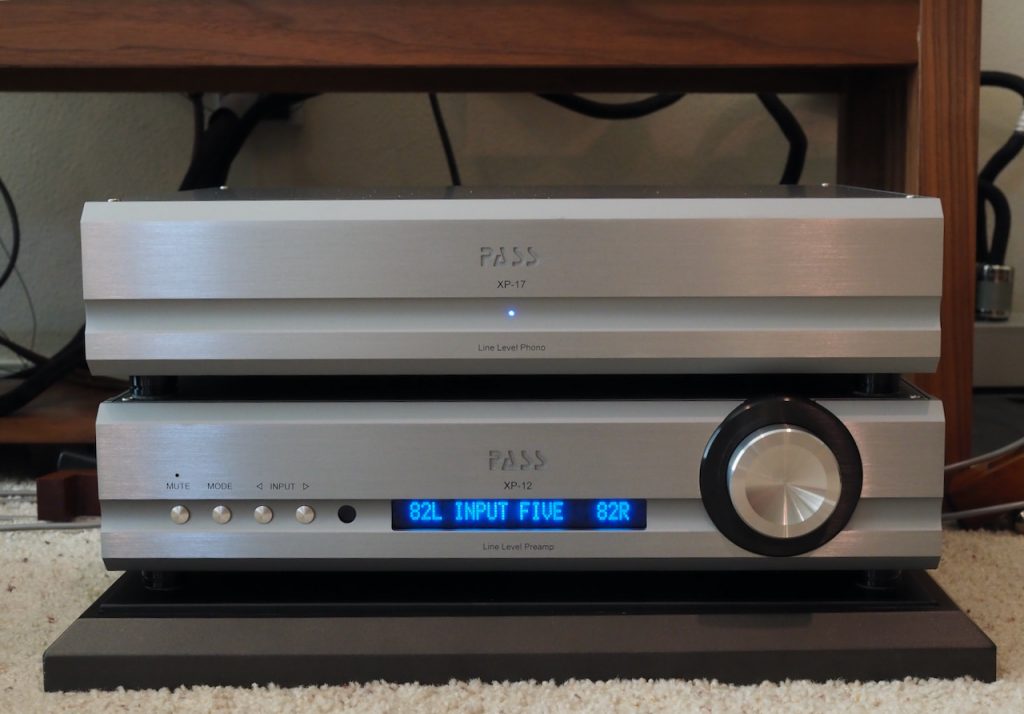
The analog source was my hot-rodded CTC Garrard 301 turntable fitted with an Audio Note (UK) Io I moving coil phonograph cartridge (more HERE).

The Audio Note (UK) CD 2.1x/II ‘Level Two’ Red Book CD player was used for a digital source (more HERE).

Interconnects were a combination of Duelund ‘Dual’ DCA16GA tinned-copper (for the CD 2.1) and Belden 8402 tinned-copper microphone cable interconnects (for the XP-12 and XP-17).
The power cables were a combination of Sablon Audio ‘Robusto’ (for the CD 2.1), Acoustic Revive ‘Absolute’ (for the XP-12 and XP-17), and an Acoustic Revive ‘Power Reference’ (for the First Watt F8).
All the power cables were plugged into an Acoustic Revive RPT-6 Absolute NCF Power Distributor, and an Acoustic Revive ‘Absolute’ power cable connected the RPT-6 to my wall outlet, which consists of an Acoustic Revive CB-1DB receptacle base plate, CFRP-1F carbon fiber outlet plate, and a Acoustic Revive modified Oyaide R-1 receptacle.
The Pass Labs XP-12 & XP-17, and the First Watt F8, were seated upon Acoustic Revive RST-38 isolation platforms.
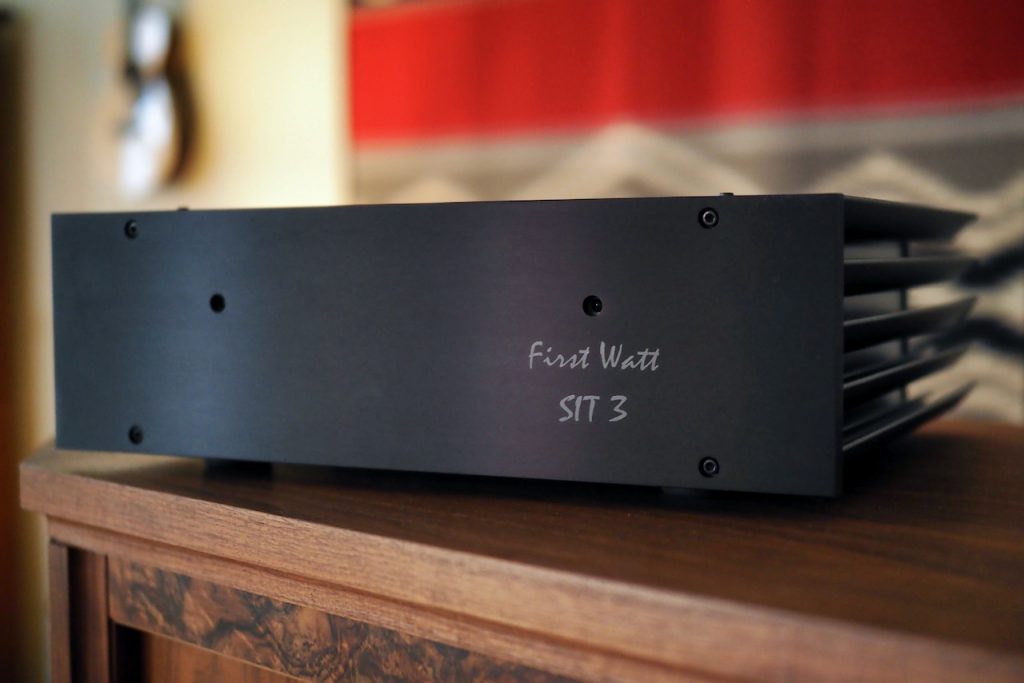
Additionally, I’ll offer a brief performance comparison of the 25 watt per channel First Watt F8 to the 18 watt per channel First Watt SIT-3 stereo amplifier (photo above, review HERE), and the 25 watt per channel Pass Labs X25 stereo amplifier (photo below, review HERE), to give you an idea of how these three high-performance low-powered amplifiers compare.
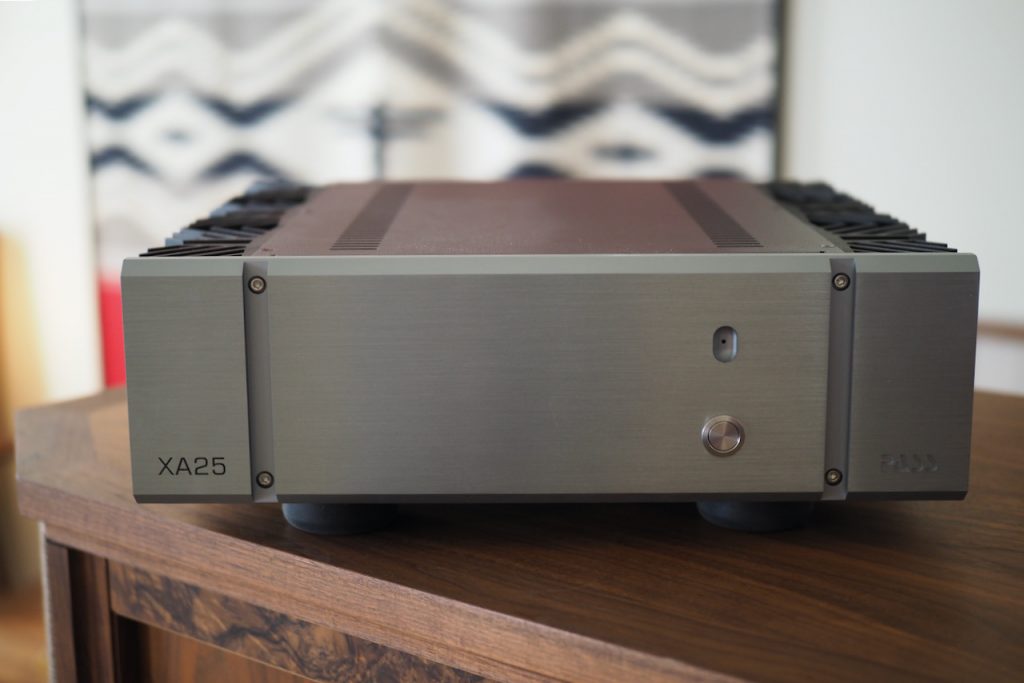
Listening Impressions
Shall we do a little physics inspired time-travel style of listening? Yes, indeed!
I have been having a lot of fun lately listening to early musical performances from the acoustic (1877–1925) and electrical (1925–1945) eras of the recording arts, in addition to my usual listening to musical performances from the magnetic (1945–1975) and digital (1975 to present) eras of the recording arts.
It turns out that quite a few of the most important musical performances ever recorded are not from the magnetic and digital eras of recording that we audiophiles typically listen to, but are from the early acoustic and electrical periods of the recording arts.
A pertinent example of important musical performances from this period can be seen in Rob Cowan's article in Gramophone, 250 Greatest Recordings of All Time: Chosen by 35 of the World's Leading Musicians (HERE).
The focus of Rob's list of recordings is on the quality of the musical performances, as chosen by leading musicians, rather than on the recording quality of the albums per se, which is often the focus of audiophile listening sessions.
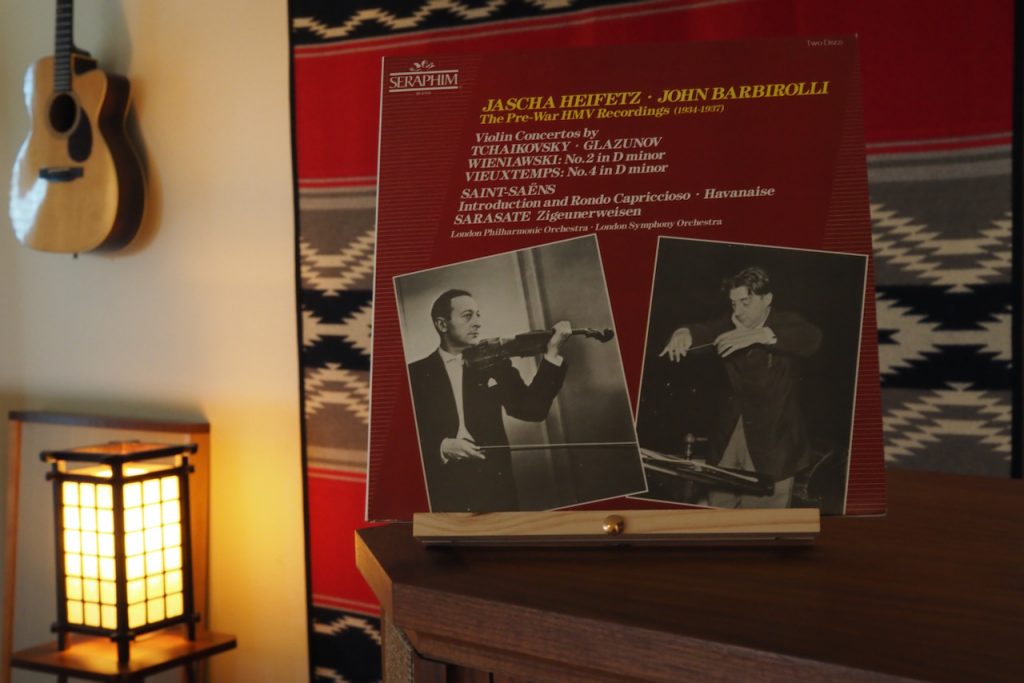
The superb musical performances of Saint-Saëns and Sarasate by Heifetz-Barbirolli that violinist Hilary Hahn chose for Rob's article in Gramophone are a perfect example.
Those performances were originally released on 78 records, which were recorded 1935-1937 by EMI during the electric recording era (1925 to 1945), and then were made available again in 1987 as the Heifetz-Barbirolli The Pre-War HMV Recordings 2 LP album set, due to their enduring importance as great performances (photo above).
The recording quality can actually be quite good from the early recording eras, although the recordings are typically noisier (but not always), and tend to have less recorded information above 6,000 Hz (but not always), than we find in the magnetic recording era, for example.
Many of those early performances were recorded direct-to-disc at 78 rpm, so you know there's a lot of good musical information stored in those grooves.
Interestingly, some of those early recordings have higher-fidelity within the bounds of their recording limitations of noise and frequency extension than do many recordings of later recording eras.
As I have been listening to recorded musical performances that span the entirety of the eras of the recording arts, it has been impressed upon me how important it is to have an audio system that can provide a high-fidelity listening experience that spans the four recording eras, rather than just from those few albums of exceptional recording quality from the magnetic and digital recording eras that we audiophiles typically listen to.
I have found that if I optimize my audio system voicing for maximum sound quality, using only audiophile-style albums, that my audio system will sound dreadful on the majority of albums from our historic recorded music canon, greatly limiting the music that I can enjoyably listen to.
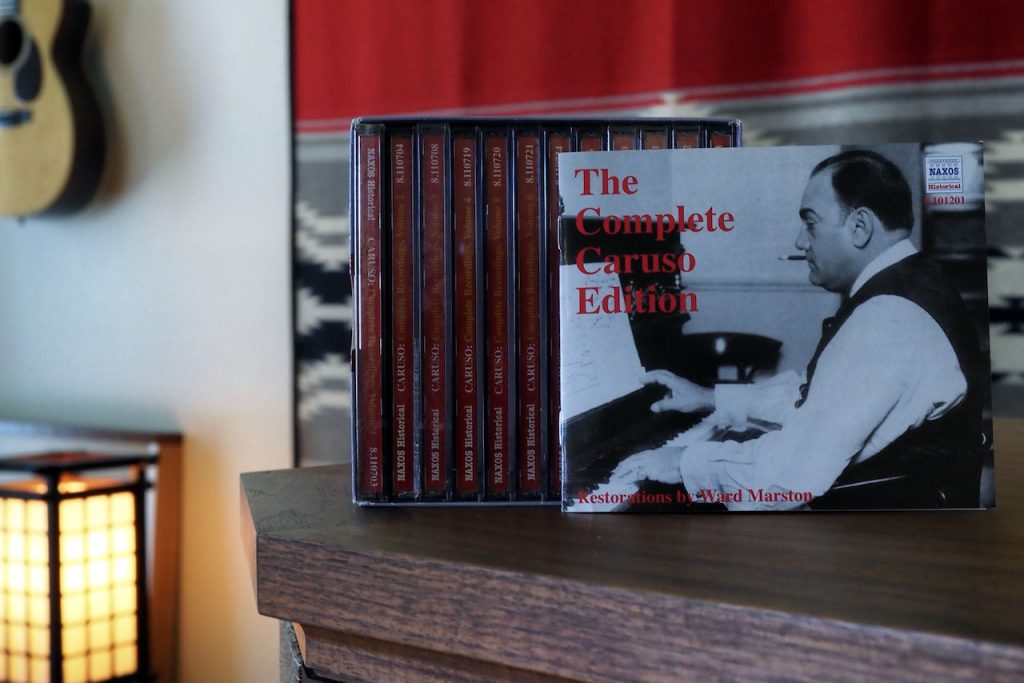
However, when I optimize my audio system to provide high-fidelity listening experiences from albums that span the entirety of our historic recorded music canon, my audio system also provides amazing listening experiences from that small subset of audiophile-style albums. That’s a win-win.
Here’s what I’ve also found out. If I listen to albums from the acoustic and electric eras of recording and they ‘sound bad’, its not actually the recordings that sound bad, but rather its the audio system voicing that needs adjusting.
When the system voicing is off, those early recordings can provide an opportunity to adjust the voicing of my audio system so that it is capable of providing high-fidelity listening experiences from all of the recording eras of our recorded music canon, which opens up new worlds of listening adventures for me.
For example, albums like Enrico Caruso: The Complete Recordings (recorded 1902 to 1920 during the acoustic era), Duke Ellington 1927-1934 (recorded during the electrical era), Miron Poliakin Plays Glazunov, Tchaikovsky, Beethoven, Schubert, and Sarasate (recorded 1938-1939 during the electrical era) are all absolutely amazing on a high-fidelity audio system, if the audio system’s voicing is up to it.

I was musing upon these aspects of music listening and audio performance as I started writing this article about Nelson’s new First Watt F8 stereo amplifier.
As I listened to some great musical performances from our recorded music canon that spanned the four recording eras, it occurred to me that instead of pronouncing the F8’s name as “F” “8”, it might be best pronounced as “Fate”, which more closely articulates how exceptionally well it provided high-fidelity listening experiences across the diverse recordings of our recorded music canon.
Not only did the First Watt F8 imbue impressive high-fidelity listening experiences to musical performances from all of the recording eras, it also provided fascinating insights into the recording techniques used in the different eras, lending a sort of auditory authenticity to the recordings that was truly illuminating, and made listening sessions feel almost like time travel experiences.
I’ll share some listening impressions with you from some of my typical listening sessions of late, where I listened to recordings that spanned the acoustic, electrical, magnetic, and digital eras of the recording arts.
Most of us don’t have a dedicated audio system for playing 78 records, but fortunately for us there are a number of record labels and individuals who are passionate about preserving recordings of great musical performances from the early recording eras, and offer transfers from those 78 records to CDs, so the rest of us can hear how remarkable those early performances and recordings were (more HERE).
I can’t overemphasize how important these early recordings are to our recorded music canon. One of my favorite quotes on the topic was made by Bruce Burroughs, Music Critic & Editor of The Opera Quarterly, in the Winter 1991/1992 issue:
“It is increasingly the case, and very sadly so, that new recordings of the landmark masterpieces of the standard operatic repertory can be satisfying on any deep level only to those with the least experience and the shortest memories … We don't go to the recordings of Caruso or Melchior, Ponselle or Flagstad for the sonics. We go because we want the real thing - the vocal capacity and dramatic ardor that cannot be dimmed by mere matters of sound reproduction. The voices fairly jump out at us from whatever dim and unsatisfactory technology enshrines them.”
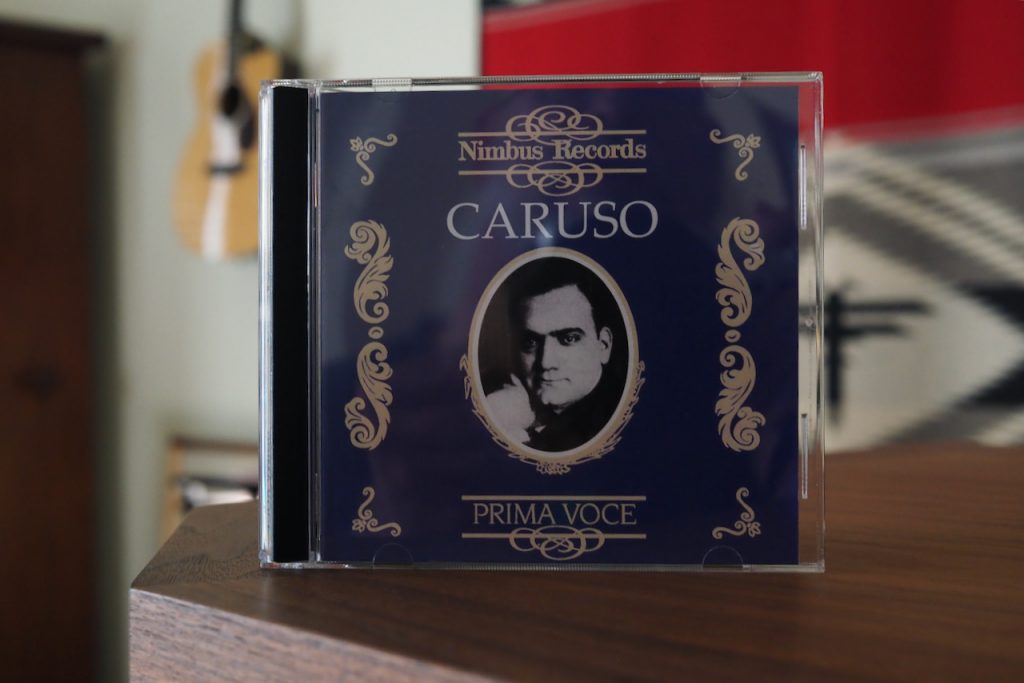
Let’s start with an example of recorded performances of Enrico Caruso from the acoustic era of recording (1877-1925), the Enrico Caruso in Opera Volume 1 1904-1920 CD, that is part of the Nimbus Records ‘Prima Voce’ series of albums offered by the Wyastone Estate in the UK.
Enrico Caruso (1873-1921) was one of the great Italian operatic tenors, and was a prolific performer, making abundant appearances in the opera houses of Europe and the Americas during his 25 year career. Case in point: Caruso performed an astonishing 863 times at the New York Metropolitan Opera alone during his career!
Fortunately for music lovers, Caruso was also an early adopter of the recording arts, and released 247 albums on 78 records during his career, and perhaps could be considered the recording arts first superstar.
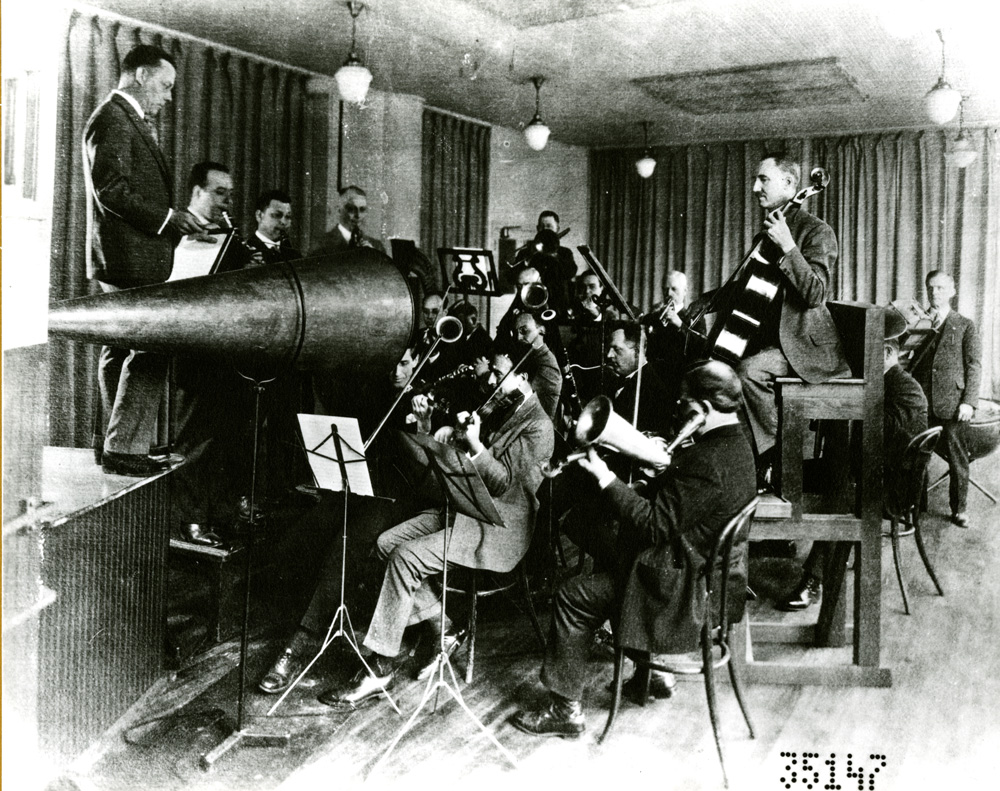
Early acoustic recording session. Photo courtesy of the US Library of Congress.
The recording equipment was mechanical during the acoustic era of recording, and the musicians were positioned in front of a recording horn, and then sang and played their instruments into the horn (photo above).
The music entering the horn was focused down to the small end of the horn, where it vibrated a diaphragm with an attached stylus, that etched the sound waves into the recording medium. The recording master was then electroplated to create a stamper, from which the record albums were made.
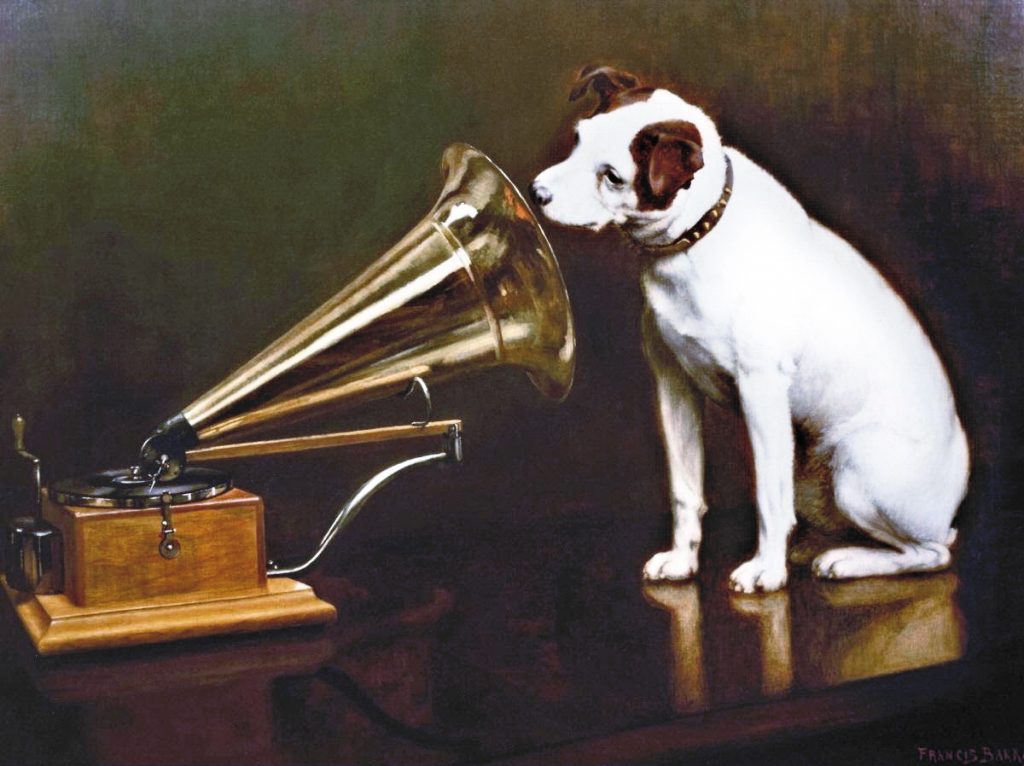
Public domain photo courtesy of Wikipedia.
Playback was also mechanical, by means of a gramophone, which essentially used the reverse of the recording process to play back the recorded performance through a horn.
The frequency extremes are missing from those early recordings, and sometimes they can have a bit of surface noise, but those direct-to-disc live recordings are rather amazing to hear on a high-fidelity audio system of today.
Ok, that's it for the sneak peek. The full article will be available to read in the next week or so from Positive Feedback, and I'll update this post to let you know when it has been published.
As always, thanks for stopping by, and may the tone be with you!



























